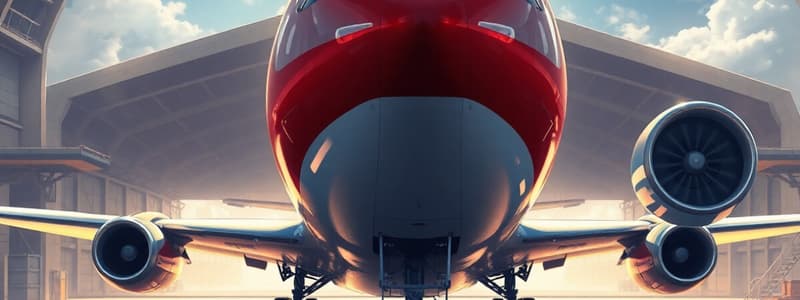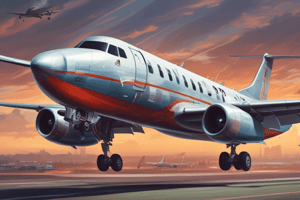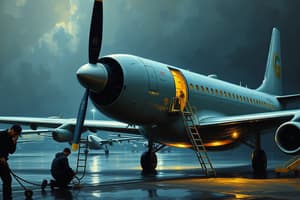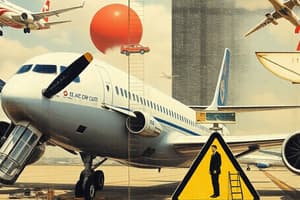Podcast
Questions and Answers
Why is a face-to-face turnover between technicians considered crucial during continuous work shifts?
Why is a face-to-face turnover between technicians considered crucial during continuous work shifts?
- To ensure the outgoing technician can leave the premises as quickly as possible.
- To ensure that any delays are blamed on the outgoing technician.
- To allow for a review of the repair documentation and confirmation of completed steps. (correct)
- To give the incoming technician a break before starting their shift.
What is the MOST significant hazard associated with loose objects on a flight line?
What is the MOST significant hazard associated with loose objects on a flight line?
- They can cause minor scratches to the aircraft paint.
- They can be ingested by aircraft engines, causing significant damage. (correct)
- They are unsightly and unprofessional.
- They can be a tripping hazard for technicians.
What should technicians assume regarding aircraft propellers?
What should technicians assume regarding aircraft propellers?
- Propellers are always stationary unless an aircraft is preparing for takeoff.
- The pilot will always warn them before starting the engine.
- Technicians must always be aware of propellers as they can be a source of danger. (correct)
- The pilot is responsible for ensuring technicians remain a safe distance away.
Which action is MOST important when dealing with damaged electrical equipment?
Which action is MOST important when dealing with damaged electrical equipment?
What are the two MOST common psychological factors that contribute to electrical accidents?
What are the two MOST common psychological factors that contribute to electrical accidents?
Why is it important to keep the areas around electrical work free of flammable substances?
Why is it important to keep the areas around electrical work free of flammable substances?
What is a direct consequence of having several broken wires inside a power cord?
What is a direct consequence of having several broken wires inside a power cord?
What is the PRIMARY purpose of using rubber gloves, safety glasses, and rubber or grounded safety mats when working with electricity?
What is the PRIMARY purpose of using rubber gloves, safety glasses, and rubber or grounded safety mats when working with electricity?
What is a critical prerequisite for a technician to safely work with electricity?
What is a critical prerequisite for a technician to safely work with electricity?
Why is heat generated when current flows through a conductor an important safety concern?
Why is heat generated when current flows through a conductor an important safety concern?
How does electricity pose a physiological safety hazard when applied to the human body?
How does electricity pose a physiological safety hazard when applied to the human body?
Why is overconfidence a safety concern when working with electricity?
Why is overconfidence a safety concern when working with electricity?
What is the recommended approach when working around a helicopter with a single main rotor?
What is the recommended approach when working around a helicopter with a single main rotor?
Why is it important to ensure that support equipment is properly secured when operating around aircraft?
Why is it important to ensure that support equipment is properly secured when operating around aircraft?
What is a critical safety measure to observe concerning turbine engine intakes and exhaust?
What is a critical safety measure to observe concerning turbine engine intakes and exhaust?
Why should wires and cords never be placed where they can be walked on or run over?
Why should wires and cords never be placed where they can be walked on or run over?
When working around oxygen systems, what is the significance of cleanliness?
When working around oxygen systems, what is the significance of cleanliness?
What precautions should be taken regarding smoking and open flames when working with or around oxygen systems?
What precautions should be taken regarding smoking and open flames when working with or around oxygen systems?
When inflating aircraft tires, why is it essential to use pressure regulators on high-pressure air bottles?
When inflating aircraft tires, why is it essential to use pressure regulators on high-pressure air bottles?
What is critical to observe before attempting any maintenance on compressed gas systems?
What is critical to observe before attempting any maintenance on compressed gas systems?
Why should compressed air never be used to clean hands or clothing?
Why should compressed air never be used to clean hands or clothing?
Why is it important to use tire dollies and other appropriate lifting devices for aircraft tires?
Why is it important to use tire dollies and other appropriate lifting devices for aircraft tires?
Regarding oxygen lines, what clearance from moving parts, electrical wiring, and fluid lines is considered adequate for safety?
Regarding oxygen lines, what clearance from moving parts, electrical wiring, and fluid lines is considered adequate for safety?
What is the primary goal of ensuring safety in manufacturing, distributing, and transporting chemicals?
What is the primary goal of ensuring safety in manufacturing, distributing, and transporting chemicals?
What is the key purpose of a Globally Harmonized System (GHS) safety data sheet?
What is the key purpose of a Globally Harmonized System (GHS) safety data sheet?
If a GHS safety data sheet has a '4' in the Health block, what does this signify about the material?
If a GHS safety data sheet has a '4' in the Health block, what does this signify about the material?
What action should employers take regarding safety data sheets (SDS) for hazardous chemicals?
What action should employers take regarding safety data sheets (SDS) for hazardous chemicals?
What is the significance of pictograms on GHS safety data sheets?
What is the significance of pictograms on GHS safety data sheets?
What does the EPA's restriction on Halon refer to?
What does the EPA's restriction on Halon refer to?
What characteristic distinguishes Halon 1211 from Halon 1301?
What characteristic distinguishes Halon 1211 from Halon 1301?
Why is it crucial to ensure that the fire extinguisher at a specific location is the appropriate type?
Why is it crucial to ensure that the fire extinguisher at a specific location is the appropriate type?
What should a periodic check of fire extinguishers include as a minimum?
What should a periodic check of fire extinguishers include as a minimum?
Why is dry powder generally not recommended for aircraft fires (except on metal fires)?
Why is dry powder generally not recommended for aircraft fires (except on metal fires)?
A fire extinguisher has 'X' marks for Class A, B, and C fires. Which type of fire is it best suited for?
A fire extinguisher has 'X' marks for Class A, B, and C fires. Which type of fire is it best suited for?
What action should be taken with unsafe air hoses?
What action should be taken with unsafe air hoses?
What is the recommended practice for connections in systems using compressed air or other gases?
What is the recommended practice for connections in systems using compressed air or other gases?
Why are water sumps important in certain systems?
Why are water sumps important in certain systems?
What is the purpose of maintaining in-line oilers in operating condition?
What is the purpose of maintaining in-line oilers in operating condition?
Flashcards
Workplace Orderliness
Workplace Orderliness
Maintaining order in areas like hangars, shops, and flight lines.
Work Shift Turnover
Work Shift Turnover
Ensuring a smooth transition of responsibilities between technicians during shift changes including review of maintenance documentation.
FOD Program
FOD Program
A program designed to prevent damage caused by loose objects near aircraft.
Damaged Electrical Cords
Damaged Electrical Cords
Signup and view all the flashcards
Electrical Safety Attitudes
Electrical Safety Attitudes
Signup and view all the flashcards
Electrical Safety Gear
Electrical Safety Gear
Signup and view all the flashcards
Lack of Respect (Electricity)
Lack of Respect (Electricity)
Signup and view all the flashcards
Condition of Electrical Wires
Condition of Electrical Wires
Signup and view all the flashcards
Electrical Safety
Electrical Safety
Signup and view all the flashcards
Heat from Current Flow
Heat from Current Flow
Signup and view all the flashcards
Hazards of Electricity
Hazards of Electricity
Signup and view all the flashcards
Approaching Helicopters
Approaching Helicopters
Signup and view all the flashcards
Helicopter Maintenance
Helicopter Maintenance
Signup and view all the flashcards
Helicopter Hazards
Helicopter Hazards
Signup and view all the flashcards
Protecting Wires
Protecting Wires
Signup and view all the flashcards
Aircraft Tire Safety
Aircraft Tire Safety
Signup and view all the flashcards
Adjusting Pressure
Adjusting Pressure
Signup and view all the flashcards
Oxygen Line Clearance
Oxygen Line Clearance
Signup and view all the flashcards
Oxygen Safety
Oxygen Safety
Signup and view all the flashcards
Oxygen System Maintenance
Oxygen System Maintenance
Signup and view all the flashcards
Cleanliness with Oxygen
Cleanliness with Oxygen
Signup and view all the flashcards
Compressed Air Safety
Compressed Air Safety
Signup and view all the flashcards
Filtered Air
Filtered Air
Signup and view all the flashcards
Goal of Chemical Safety
Goal of Chemical Safety
Signup and view all the flashcards
GHS Safety Data Sheet (SDS)
GHS Safety Data Sheet (SDS)
Signup and view all the flashcards
RAD, ALK, ACID, CARC
RAD, ALK, ACID, CARC
Signup and view all the flashcards
GHS Pictograms
GHS Pictograms
Signup and view all the flashcards
Hazard Rating Scale (0-4)
Hazard Rating Scale (0-4)
Signup and view all the flashcards
Fire Extinguisher Inspection
Fire Extinguisher Inspection
Signup and view all the flashcards
Fire Extinguisher Checkpoints
Fire Extinguisher Checkpoints
Signup and view all the flashcards
Dry Powder Extinguisher Issues
Dry Powder Extinguisher Issues
Signup and view all the flashcards
Halon 1211 Benefits
Halon 1211 Benefits
Signup and view all the flashcards
Halon 1211
Halon 1211
Signup and view all the flashcards
Halon 1211 vs. 1301 Spray
Halon 1211 vs. 1301 Spray
Signup and view all the flashcards
Halon 1301
Halon 1301
Signup and view all the flashcards
Oxygen Safety: Distance
Oxygen Safety: Distance
Signup and view all the flashcards
Fire Extinguisher Check Points
Fire Extinguisher Check Points
Signup and view all the flashcards
Air Hose Condition
Air Hose Condition
Signup and view all the flashcards
Study Notes
- Proper arrangement and upkeep of hangars, shops, and flight lines are essential.
- In workplaces with ongoing work shifts, the incoming technician must satisfactorily complete any work signed for.
- It is crucial to review the repair/maintenance paperwork to verify that all steps have been signed off by the previous technician.
- A face-to-face handover explaining the progress made and pinpointing the exact step where the new technician should continue is required.
Safety Precautions - Aircraft and Workshop
- Be conscious of propellers and never assume the pilot can see the technicians.
- The significance of an FOD (Foreign Object Damage) program cannot be overstated because loose objects propelled with enough force can cause damage.
- Provide convenient receptacles for trash, used hardware, shop towels, and other waste.
- Implement a tool control program to avoid FOD.
- Keep maintenance stands, hoses, electrical cords, hoists, crates, and boxes organized and away from work areas.
Electrical Safety Precautions
- Those lacking the skills to handle electrical equipment safely should not attempt to do so.
- Repair or replace any damaged electrical equipment before further use and closely monitor its condition.
- A lack of respect for electricity is often due to a lack of knowledge.
- Maintain a certain level of respect for electrical equipment, as well as confidence; extremes of either can be deadly.
- Fear and overconfidence are two major causes of electrical accidents.
- When several wires inside a power cord are broken, the current passing through the remaining wires increases, wire coatings can melt, and can lead to fire.
- Keep all power cords, wires, and lines free of kinks and bends which can cause damage.
- An important component in preventing electrical fires is maintaining a clean area around electrical work, since flammable substances can ignite.
- Rubber gloves, safety glasses, rubber or grounded safety mats, and other equipment offer both psychological assurance and physical protection.
- Working knowledge of electricity, respect for its capabilities, and the use of proper safety equipment are necessary to deal with it safely.
- Any current flow produces heat, which can damage affected systems or components.
- Electrical current applied to the human body can create physiological safety hazards, such as severe burns at entry and exit points.
- The nervous system can be affected by electric shock.
Safety Around Helicopters
- Each helicopter type has unique features that maintenance personnel must be aware of.
- Consult the maintenance manual for the proper method when securing the rotor on helicopters with elastometric bearings, as using the wrong method could cause damage or injury.
- When approaching a helicopter while the blades are turning, observe the rotor head and blades to see if they are level.
- Always approach the helicopter in view of the pilot and allow space between it and parked aircraft to prevent it from rolling into the aircraft.
- Ensure all items in the area of operating aircraft are properly stowed.
- Never go from one side of a running helicopter to the other by going around the tail; instead, always go around the nose of the helicopter.
- The tail rotor is typically invisible when operating, and turbine engine intakes and exhaust can be hazardous.
- Never approach a single main rotor helicopter from the rear.
- Avoid carrying anything with flames near an aircraft in operation, and be aware of aircraft fluids which can be harmful to skin.
- Ensure adequate space between operating support equipment and aircraft to prevent blade strikes and personal injury.
- There should be no smoking or open flames anywhere near an aircraft and never place wires or cords where they will be walked on because this will damage the wire.
Safety Around Compressed Gases
- Like electricity, compressed air is an excellent tool if used with extreme caution.
- When inflating tires on any type of aircraft wheels, personal injury and over-inflation can be avoided by using pressure regulators.
- A typical nitrogen bottle set is used for inflation of high-pressure tires.
- Secure compressed gas cylinders to prevent them from falling.
- Use tire dollies and other mounting devices when mounting or removing heavy aircraft tires to prevent possible personal injury during aircraft tire mounting.
- The following apply when working with compressed gases: Ensure compressed gas and servicing equipment are clean and avoid power-on checks and use of the aircraft electrical system.
Oxygen Safety Considerations
- Keep a distance between pure oxygen and petroleum products, because when combined, an explosion can result.
- A variety of maintenance practices should be followed to ensure safety when working with oxygen and oxygen systems, and maintenance should be done outside as much as possible.
- The aircraft maintenance manual warnings and precautions must be followed carefully.
- Before attempting work, an adequate fire extinguisher should be on hand.
- Cordon off the work area and post "NO SMOKING" placards a minimum of 50 feet from the area and on all containers.
- Clean, grease-free hands, clothes, and tools are essential and use only dedicated tools for oxygen components.
- Always use protective caps and plugs when working with oxygen cylinders, system components, or plumbing and never use any kind of adhesive tape.
- Oxygen cylinders should be stored in a designated, cool, ventilated area in the hangar, away from petroleum products or heat sources.
- Oxygen system maintenance should not be accomplished until the valve on the oxygen supply cylinder is closed and pressure is released from the system slowly to allow any residual pressure to dissipate.
- Use filtered air for paint spraying to remove oil and water.
- The system should have water sumps installed and drained regularly.
- In-line oilers should be maintained in operating condition, if installed.
- All connections should be kept in a "no-leak condition".
- Air hoses should be inspected frequently for breaks and worn spots, and unsafe hoses replaced immediately.
- Never spray compressed air in the area of other personnel and avoid using it to clean hands or clothing, because pressure can force debris into the flesh leading to infection.
Safety Around Hazardous Materials
- Performing maintenance on aircraft and their components involves the use of different materials during manufacturing, distributing, and transporting.
- The goal of hazard communication is to ensure the safety of user personnel that come into contact with hazardous chemicals.
- The Globally Harmonized System of Classification and Labeling of Chemicals (GHS) was adopted by the European Union in EC 1272/2008 and standardizes hazard communication worldwide.
- A material safety data sheet (MSDS or SDS) contains information for the safe handling, use, storage, and disposal of potentially hazardous chemicals that manufacturers and distributors of these substances provide to users.
- Employers are required to make chemical hazard information available to their employees.
- GHS safety data sheets are accompanied by standardized labeling pictograms or symbols which categorize physical hazards, health hazards, and environmental hazards.
Fire Safety
- Fire extinguishers should be marked to indicate suitability for a particular class of fire and checked periodically, utilizing a checklist.
- Airport fire departments or other local fire departments can provide helpful extinguisher checklists and assistance.
- The checklist for inspection of fire extinguishers as a minimum includes things like:
- No obvious damage
- No nozzle obstruction
- Proper weight
- All external dirt and rust removed
- Gauge or indicator in operable range
- Safety seals unbroken
- Proper location of appropriate extinguisher
- Dry powder fire extinguishers are useful for Class D fires.
- The function of dry powder fire extinguishers varies, but all expel the powder from the container with force.
- Multipurpose Dry Chemical types may be insufficient for Class 'A' fires
- Dry powder is not recommended for aircraft use (except on metal fires) because the leftover chemical residues and dust often make cleanup difficult.
- Bromochlorodifluoromethane (Halon 1211), chemical formula CBrClF2, is a liquefied gas with a UL toxicity rating of 5 and is colorless and noncorrosive.
- EPA has restricted Halon to its 1986 production level due to its effect on the ozone layer.
- Bromotrifluoromethane (Halon 1301), chemical formula CF3Br, is also a liquefied gas with a UL toxicity rating of 6.
- Halon 1211 forms a spray similar to CO2, while Halon 1301 has a vapor spray that is more difficult to direct.
Studying That Suits You
Use AI to generate personalized quizzes and flashcards to suit your learning preferences.




